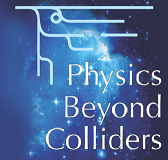Speaker
Description
The magnetic moments of baryons containing u,d and s quarks have been extensively studied and measured. The experimental results are all obtained by a well-assessed method that consists in measuring the polarisation vector of the incoming particles and the precession angle when the particle is travelling through an intense magnetic field. The polarization is evaluated by analysing the angular distribution of the decay products. No measurement of magnetic moments of charm or beauty baryons (and τ leptons) has been performed so far. The main reason is the lifetimes of charm/beauty baryons, too short to measure the magnetic moment by standard techniques.
One proposal to meet the challenge of measuring the magnetic moments of baryons with heavy flavoured quarks is to use the strong effective magnetic field inside the channels of a bent crystal instead of the conventional magnetic field to induce the precession of the polarization vector and measure the magnetic moment. The detailed precession theory has been developed in Ref. [1]. E761 Collaboration (1992) had demonstrated the feasibility of this idea by measuring the magnetic moment of the strange Σ+ baryon [2] using the decay into pπ0.
In this talk we investigate scenarios and propose an experiment to measure the magnetic moment of the Λc and other charmed charged baryons at SPS and at LHC top energies. For the proposed experiments, the length and the crystal bending angle should be optimised at the different energies, to provide the maximal channelling efficiency. On the other hand, the crystal should be tightly packet with the target and tested to maximize the Λc yield taking into account the very short decay length of the charmed baryons. The detector should be very close to the crystal-target pack to maximize the yield. The unavoidable drawback would be the heavy background produced by the primary proton beam travelling close-by. The proposed experiment at SPS should be performed in the CERN North Area, whilst the LHC experiment should be kept in the LHC vacuum pipe and if possible use one of the existing LHC detectors.




